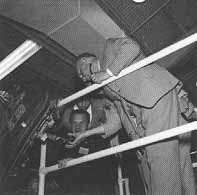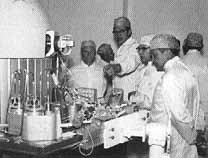
Spacecraft Familiarization
At the March 1973 Working Group meetings, Shatalov, in charge of cosmonaut training, and Bob Overmyer worked to pull together a "Crew and Ground Personnel Training Plan," ASTP 40 700, which defined the study and practice sessions that would be held for crews, flight controllers, and other control center staff. They agreed that there would be three training sessions in the U.S.S.R. and three in the United States. Instead of trying to second-guess the curricula for the second and third meetings, they planned to let the host country advise its guest team a month or so in advance of the training agenda. Any updated material should be added to the training plan by a document change notice. The length of the meetings would be kept flexible in an effort to provide an adequate stay for the orientations but not waste time. Cosmonauts would visit Houston in July, and the astronauts hoped to travel to Star City in the fall.21
In anticipation of the familiarization visits, the Soviets lowered another barrier in their space program during June 1973 - they invited a delegation of American aerospace writers to visit Zvezdny Gorodok (Star City). Donald Winston and Robert Hotz of Aviation Week and John Shaw and Jerry Hannafin of Time were among those who toured the facilities. The correspondents were impressed by the vitality of the Soviet space program. Shaw reported: "Unlike the Johnson Space Center[*] in Houston, where major retrenchments are underway, Star City is rapidly expanding a sure sign of the Soviet Union's continued dedication to the exploration of space."22 Aviation Week [253] agreed: "The building activity underscores Russia's determination to retain capability in manned space missions despite a series of set backs that has forced an unscheduled two-year hiatus in manned orbital flights by that country."23 From their conversations with General Shatalov, the reporters learned that the cosmonauts were making special preparations for work with their American counterparts.
Ten cosmonauts - the ASTP crews, Yeliseyev, and Shatalov - and four Soviet training specialists arrived in Houston with the rest of the Working Groups on 8 July 1973. At the request of the Soviets, a large block of time was set aside for them to listen to taped recordings of actual Apollo air-to- ground conversations. While getting a better idea of what they would be hearing during the mission, they also reviewed the "Glossary of Conversational Expressions between Cosmonauts and Astronauts during ASTP," which was a step toward standardizing the mission language. This work was followed by a series of video taped presentations on the command and docking modules that had been prepared by Rockwell International and narrated by Alex Sementovsky, one of Rockwell's Russian-speaking engineers.
Each of the video lectures was followed by a question and answer period. By presenting the basic material in Russian the first time, considerable training time was saved. These tapes, covering the design and operation of the Apollo spacecraft systems, were supplemented by handouts with the same material and illustrations, and both were taken home so the cosmonauts could spend as much time with the topics as they felt was necessary. After participating in a discussion with other Working Group 1 members on the "Joint Crew Activities Plan," ASTP 40 301, each cosmonaut was given a ride in the command module simulator, so he could get a better understanding of how some of the command module systems worked and observe the simulator's capabilities. Following that exercise, the Soviets had an opportunity to examine the docking module mockup and study its systems.24
[254] Visit to Rockwell Command and Service Module Production Facility at Downey, California, 14 July 1973
 |
 |
|
[above] The Soviets are shown the Apollo 17 heatshield, which had been removed from the command and service module in the rear. From left to right, A. S. Ivanchenkov, A. S. Yeliseyev, N. N. Rukavishnikov, V. N. Kubasov, K. D. Bushuyev, T. P. Stafford, A. Tatistcheff, and C. W. Helms.
|
[above] Tom Stafford, behind Professor Bushuyev, explains the functioning of the hatch quick opening mechanism to the Professor and Cosmonauts Kubasov and Ivanchenkov.
|
 |
George Merrick, Vice President, Space Division, Rockwell International, explains the cryogenic equipment to be installed in the service module. His audience consists of, from left to right, Bushuyev, Sementovsky , and Filipchenko.
|
|
Leo Krupp, Supervisor of Pilot Technology at Rockwell, explains layout of mockup of Shuttle Orbiter cockpit to Professor Bushuyev.
|
 |
On 14 July, Lunney and Bushuyev accompanied the cosmonauts to Rockwell International's factory at Downey. Once there, the Professor and his comrades were able to observe work being done on CSM 111, examine a high fidelity mockup of the docking module, and study the effects of reentry on several command modules stored at Downey. Their factory tour ended with a demonstration of the Apollo docking and entry simulators. The Soviets returned to Houston for another week of activities before departing for Moscow on 21 July.25
Reporters speculated that the Soviets had left when they did to avoid having to accept Glynn Lunney's invitation to watch the 28 July launch of [255] the second Skylab crew. Bushuyev, when questioned at the press conference closing the two-week stay, said that they had accomplished all of their objectives and that remaining for a third week would have presented "difficulties for some of [our] side because some of the participants in our delegation have duties at home which cannot be postponed."26 Whether the Soviet spokesman was making excuses or whether some members of his team were going home to prepare for the launch of Soyuz 12 is unclear. Nevertheless, the termination of the meetings was completely in line with the agreement not to waste time. The cosmonauts had completed their work, and they and the astronauts would begin readying themselves for their Moscow session.
* The Manned Spacecraft Center had been renamed in honor of Lyndon B. Johnson in a congressional act signed by President Nixon on 17 Feb. 1973.
21. "Apollo Soyuz Test Project Crew and Ground Personnel Training Plan," ASTP 40 700, 26 Mar. 1973.
22. "Soviet Space: A visit to Star City," Time, 9 July 1973. John Noble Wilford of the New York Times had been one of the first Western news persons to visit Star City when he toured the center in March 1972 during his month sojourn in the U.S.S.R. His evaluation of the Soviet center and the pace of the Soviet program was similar to those in Time and Aviation Week; Wilford, "Friendly, Yes, but Trying to Be First," New York Times. 28 Mar. 1972.
23. Donald C. Winston, "Soviet Space Center Being Expanded," Aviation Week & Space Technology, 25 June 1973, p. 18.
24. "Minutes, Joint Meeting of Working Group 1," in "Apollo Soyuz Test Project, Minutes of Joint Meeting, USSR Academy of Sciences and US National Aeronautics and Space Administration," 9-20 July 1973; and interview, Mike S. Brzezinski-Ezell, 23 Sept. 1975.
25. "Minutes, Joint Meeting of Working Group 1," 9-20 July 1973; and NASA News Release, HQ [unnumbered], "Communique on Results of Apollo Soyuz Test Project Meetings, July 8-20, 1973" [20 July 1973].
26. NASA Press
Conference, JSC, "Apollo-Soyuz Test Project (ASTP) Technical
Directors and Prime Crew Press Conference," 20 July 1973; Wilford,
"Astronauts from Soviet and U.S. Begin a Briefing in Houston for
Joint Mission," New York
Times, 10 July 1973; "Cosmonauts Hear
Lectures," Houston Post, 11 July 1973; and Jack Waugh, "Building U.S.-Soviet
Space Team," Christian Science
Monitor, 19 July 1973.
Next